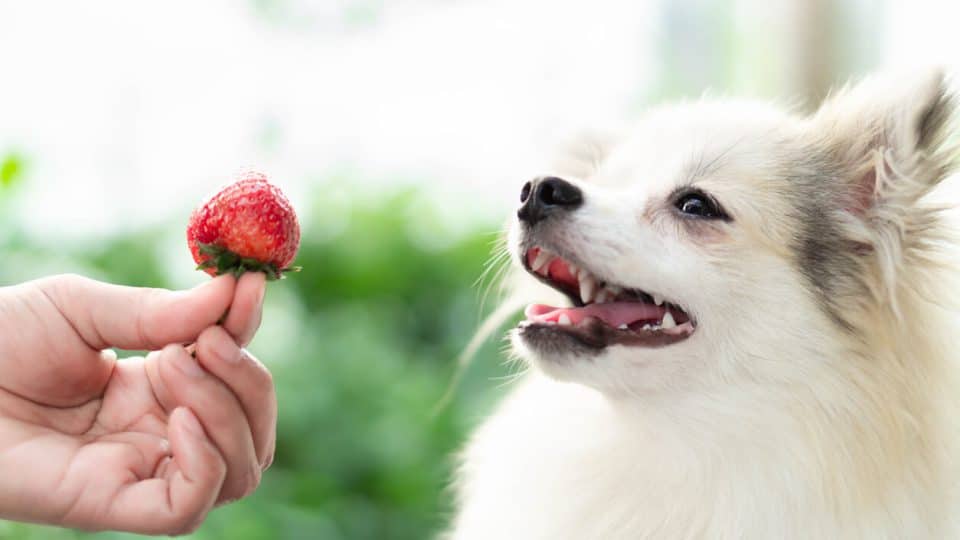- Not a substitute for professional veterinary help.
With their bright red colour and juicy sweetness, fresh strawberries make a delicious addition to many summertime dishes and desserts. And of course, if you enjoy eating strawberries yourself, you might wonder if your dog can safely snack on them, too.
Yes, dogs can eat ripe strawberries, as long as you remove the stems, says Renee Schmid, DVM, DABT, DABVT, a veterinary toxicologist at Pet Poison Helpline in the USA. In fact, Schmid adds, strawberries are an excellent source of vitamins and antioxidants for dogs.
Below, get more details on the best way to serve this sweet summertime snack to your dog, plus a few canine-friendly strawberry recipes.
Can Dogs Eat The Whole Strawberry?
Unlike other human foods dogs shouldn’t eat, strawberries and their parts don’t contain anything toxic, Schmid says.
That said, strawberry stems and leaves can cause some other tummy troubles, Schmid says, so you should remove these first.
| Part of the strawberry | Can a dog eat it? |
| Red flesh | Yes |
| Leaves | No. They’re non-toxic but difficult for dogs to digest. |
| The white section | Yes |
| Seeds | Yes |
| Stems | No. They’re non-toxic but difficult for dogs to digest. |
How Many Strawberries Should I Feed My Dog?
Treats like strawberries shouldn’t make up more than 10% of your pet’s daily calorie intake.
There’s no set number of fresh strawberries your dog can eat. But maxing out their daily treats with strawberries may leave them feeling a little unwell—especially if they have a sensitive stomach.
“Strawberries contain a high level of natural sugars that can cause some digestive upset. They can also cause medical issues in dogs with certain conditions like diabetes,” says Leasa Moltke, manager of nutrition and regulatory affairs at Solid Gold.
Before introducing new food to your pup, it’s always wise to check with your vet, especially if your dog has an existing health condition. Begin by offering just one at a time to make sure your dog enjoys them and doesn’t have an adverse reaction.
Keep in mind, too, that ripe strawberries are less likely to cause an upset stomach than unripe strawberries, according to Schmid.
Do Strawberries Have Benefits For Dogs?
Since dogs are omnivores, they can eat and benefit from a variety of fruits and vegetables—and strawberries are a nutritious, low-calorie snack.
They provide these important vitamins:
- Vitamin C. This antioxidant helps protect the body from harmful free radicals, reduces inflammation, and supports immune function.
- Vitamin B1. Also called thiamine, vitamin B1 plays an essential role in the function of organs like the brain and heart.
- Vitamin B6. Your dog needs vitamin B6, also known as pyridoxine, for brain, nerve, and immune system development and function.
- Vitamin K. This vitamin plays a critical role in blood clotting.
- Potassium and iodine. These micronutrients help maintain the balance of water in the body. Potassium helps keep the right amount of water inside cells, while iodine does the same for water outside of cells. Potassium also helps muscles move and regulates blood pressure.
- Magnesium. This mineral helps enzymes build proteins and strong bones while also regulating blood sugar and blood pressure. It also aids in nerve functions and movement of muscles, including the heart.
- Fibre. Fibre keeps your dog’s digestive system regular. It can also keep your dog fuller between meals, which can help them maintain a healthy weight.
- Omega-3. This fatty acid helps keep your dog’s brain, eyes, skin, joints, and immune system healthy and functioning.
- Folic acid. Also called vitamin B9, this essential nutrient helps make DNA and RNA. It has several important functions, including lowering heart disease risk, supporting cell growth and renewal, making red blood cells, developing the brain and nerves, and producing chemicals that affect mood and memory.
Potential Risks Of Feeding Your Dog Strawberries
If you do give your dog strawberries, you’ll want to stick with fresh ones—canned strawberries are a dessert best enjoyed by people, Schmid says.
“An important ingredient to watch out for is xylitol, which may be added to sugar-free canned strawberries or potentially even products that also contain sugar,” she says.
If a dog eats something containing xylitol, they can experience a rapid and severe decrease in blood sugar levels and potentially liver failure.
Vets also don’t recommend sharing strawberry cake, ice cream, or other sweets with your dog. Not only do these foods contain a lot of calories and sugar, they may also contain ingredients harmful to dogs.
Important: If you think your dog has eaten strawberries with xylitol or other toxic spices, contact your regular vet or the Animal PoisonLine, where experts can offer guidance on next steps for a fee.
Keep in mind, too, that whole frozen strawberries could become a choking hazard if your dog swallows them without chewing. This may be even more likely if your dog is a fast eater.
If you’re worried your pup might choke on a whole strawberry, slice them before serving. You can also stick to soft dog-friendly fruits and veggies like bananas, boiled sweet potatoes, or peaches with the pit removed.
Serving Suggestions And Recipes
If your dog enjoys strawberries, feel free to toss them one or two. You can also incorporate strawberries into your dog’s snack or meal with these ideas:
- Add sliced or mashed fresh strawberries as a topper to your dog’s food
- Offer your dog sliced and frozen strawberries
- Blend strawberries into a dog-friendly smoothie
- Freeze pureed strawberries in ice cube trays for a summer treat
- Purchase dog treats with strawberries
You can also try these recipes:
Nutritious strawberry pupsicles
Moltke says these dog-friendly pupsicles are her favourite way to serve summertime strawberries to pups.
Directions:
- Slice or blend four to six strawberries
- Combine them with a homemade bone broth or a commercially prepared one
- Add 57 grams (1/4 cup) of yoghurt (optional)
- Mix or blend all ingredients
- Spoon the prepared batter into ice cube trays or silicone moulds
- Freeze until solid
Dog-friendly strawberry ice cream
Our Rover chef came up with a pup-friendly ice cream. And the best part is, you can use any dog-safe fruit!
Directions:
- Dice a few cups of berries, removing any stems or leaves
- Place in the freezer for four hours (or overnight if you prefer)
- Place one-and-a-half cups of frozen berries in your food processor
- Add 1/4 cup of yoghurt (substitute with coconut milk or coconut yoghurt for dogs with a lactose sensitivity)
- Blitz in the food processor, adding more fruit or yoghurt to adjust flavour and texture
- Serve immediately
Important: When sharing fruit with your pup, always remember to skip the grapes, as they’re toxic to dogs.




